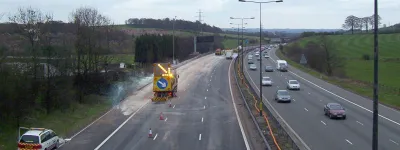History
While Rannoch Moor may be one of the last true wildernesses in the British Isles, it has for centuries provided the main link between the West Highlands and the Central Belt of Scotland. In medieval times, almost from the birth of any kind of market economy in Scotland, cattle were being herded across the moor to be sold at market. These drovers' routes were probably marked by cairns on small knolls, signifying the safest routes.
One such route was the Road to the Isles. This may be the modern tourist name for the A830, but its origins go back much further, with the historic drove route running from Arisaig, through the dangerous Glen Nevis, and then crossing the eastern fringe of Rannoch Moor, past Corrour, and into the upper reaches of the Tay Valley.
Another route skirted the western fringe of the moor, to reach Strath Fillan and so the shores of Loch Lomond, much as the modern A82 does today. It was this route that General Caulfeild decided upon when planning the Military Road North. Work was only carried out in the summer months, from late April or May until September. The road across Rannoch Moor from Tyndrum to Fort William was, by all accounts, completed in two summers - 1751 and 1752. Such a rapid progression suggests a large number of work parties each building their own sections. It would also go to explain the poor quality of road that Telford found fifty years later.
As with most modern travellers, Caulfeild started from the south, using existing tracks and drove routes to reach the inhospitable edge of the moor at Bridge of Orchy. The current crossroads outside the Hotel shows Caulfeild's route, and the bridge over the River Orchy is the bridge that he constructed in 1751.
Beyond Kingshouse, Telford's road soon diverges to take the route now used by the modern road, while the WHW runs along the hillside higher up. The maps mark this as the route of the Military road, but on the ground there is little evidence to support this. After 250 years nature has reclaimed the road and the modern footpath uses timber bridges to cross the streams, while weaving round boulders that almost create a new alignment.
After about 5.5Km (3½ miles), the Old Military Road once more reappears in it's own right. The steep climb from Altnafeadh leads to the even steeper zigzags of the Devils Staircase. It is this route that the WHW also takes to get to Kinlochleven, and through the Lairig Mor to Fort William. All subsequent main routes have taken the far easier gradients through Glencoe, which is part of the original drovers route.
Apart from the concerns over problems with the residents of Glencoe, this route also avoided the need for any kind of ferry across Loch Leven, and the Lairig Mor is in many ways a much more suitable route for a modern road than the precarious ledge along the shore of Loch Linnhe that the A82 uses. It should also be remembered that the military roads were built primarily for troop movements: animals, carts and other wheeled traffic were very much of secondary importance when the roads were surveyed and built.
